Diving into the world of web design, we’re thrilled to chat with Vijay Raina, a trailblazer in creating subtle, ambient animations that breathe life into websites. With a rich background in crafting digital experiences, Vijay has mastered the art of using motion to enhance brand identity and user engagement without overshadowing the content. In this conversation, we explore how he weaves personality into designs through gentle animations, balances creativity with functionality, and adapts his approach across diverse projects. From reflecting a composer’s unique style to reimagining visuals for a property investment firm, Vijay shares insights on the principles, techniques, and thoughtful considerations behind his work.
How would you describe ambient animations in the context of web design, and what makes them stand out from more in-your-face animation styles?
Ambient animations are those quiet, understated movements on a website that you might not consciously notice at first, but they add a layer of depth and personality. Think of elements slowly shifting, colors fading gently, or objects drifting almost imperceptibly. Unlike bold or aggressive animations that demand attention, ambient ones work in the background, creating a sense of life without pulling focus from the main content. They’re effective because they tap into subtle emotional cues—making a site feel warm, dynamic, or unique—without overwhelming the user or slowing down their experience.
What draws you to using ambient animations as a tool to express a brand’s personality on a website?
I’ve always believed that a website should feel like an extension of the person or brand behind it. Ambient animations are a fantastic way to do that because they can mirror a brand’s essence in a way that’s not overt. For instance, slow, rhythmic movements can evoke calm and trust for a professional service, while playful, organic motions might reflect creativity for an artist. They let me tell a story or set a mood without relying on heavy text or imagery, embedding the brand’s vibe directly into the user’s interaction with the site.
Can you share how you’ve used inspiration from historical design to inform your animation choices in a specific project?
Absolutely. In one project for a composer based in Los Angeles, I drew inspiration from the iconic album cover designs of the mid-20th century, particularly those with a strong sense of texture and depth. I wanted the website to reflect his classical and jazz influences, so I incorporated elements like morphing sheet music lines and drifting notes. These animations weren’t just decorative—they captured the fluidity and emotion of his music, creating a visual harmony that felt true to his identity as an artist.
How do you use techniques like layering to add complexity to animations while keeping them subtle?
Layering is all about creating depth without chaos. I approach it like composing a piece of music—different elements move at their own pace or rhythm to build a cohesive whole. For example, in the composer’s site, I had musical notes drifting at varying speeds across the screen, mimicking a parallax effect. Slower notes in the background paired with slightly faster ones upfront give a sense of dimension. The key is timing and balance; I tweak durations and easing until nothing feels jarring. It’s about guiding the eye naturally, not forcing it to jump around.
When blending interactive elements with ambient animations, how do you decide where to draw the line so one doesn’t overpower the other?
It’s a delicate balance. I start by asking what the interaction’s purpose is—does it serve the story or enhance usability? In a project for a film composer, I created a character illustration with ambient movements, like subtle shifts in posture, but added an interactive feature where users could toggle light effects in a cave scene. The interaction was tucked away as a delightful surprise, not a focal point. I ensure the ambient animations remain slow and passive, while interactive elements are triggered by user choice, so they feel rewarding rather than disruptive.
What challenges do you face when designing animations for industries that typically lean toward conventional or conservative visuals?
The biggest challenge is breaking away from the expected without alienating the audience. For a property investment company, I moved away from the usual generic cityscape banners and designed stylized skylines with gentle animations like rotating wheels and flickering lights. The challenge was to keep it professional yet distinctive. I had to dial back the motion so it wouldn’t feel gimmicky, ensuring it stayed in the background while still hinting at the company’s global reach and dynamic nature. It’s about finding small ways to innovate within tight constraints.
How do you approach the technical side of ambient animations to ensure they’re both effective and accessible to all users?
Technically, I prioritize performance and accessibility from the start. I often use CSS for simple effects like fades or rotations because it’s lightweight, but for more complex sequences, like path morphing, I turn to tools like GSAP for precision. I’m mindful of device capabilities—avoiding heavy effects like blurs on low-powered devices—and I always respect user preferences, such as reduced motion settings, by disabling animations if needed. Additionally, decorative animations get tagged with accessibility attributes to avoid cluttering screen readers. It’s about making sure the experience is smooth and inclusive for everyone.
What’s your forecast for the role of ambient animations in the future of web design?
I think ambient animations will become even more integral as web design continues to prioritize emotional connection and storytelling. With advancements in browser capabilities and tools, we’ll see more seamless, lightweight animations that adapt to user contexts—like time of day or device type—making experiences feel more personalized. I also expect a stronger focus on accessibility, ensuring these subtle motions enhance rather than hinder usability. Ultimately, ambient animations will evolve as a quiet but powerful way to differentiate brands in an increasingly crowded digital space.









